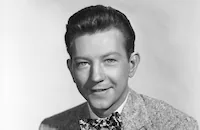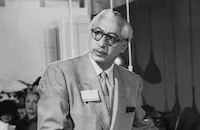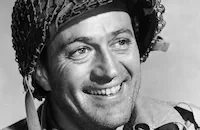That Funny Feeling

Brief Synopsis
Cast & Crew
Richard Thorpe
Sandra Dee
Bobby Darin
Donald O'connor
Nita Talbot
Larry Storch
Film Details
Technical Specs

Synopsis
Aspiring actress Joan Howell, who makes a living as a maid, has a number of accidental encounters with Tom Milford, a New York City publishing company executive. After their third such meeting, she invites him to her apartment, but, ashamed of her one-room residence, she borrows the apartment of one of her employers whom she has never seen. Tom (who is the employer) cancels a trip and is surprised to see Joan in his own apartment, but he goes along with the ruse and moves in with his partner, Harvey. Eventually, each discovers the other's identity, but neither reveals the truth. Joan decides to play a trick on Tom and invites his former girl friends to a party, asking them to dress as prostitutes. The police raid the party, and as they are headed for jail, Joan accepts Tom's marriage proposal.

Director

Richard Thorpe
Cast

Sandra Dee

Bobby Darin

Donald O'connor

Nita Talbot
Larry Storch

James Westerfield

Leo G. Carroll

Robert Strauss
Ben Lessy

Reta Shaw
Nora Marlowe
Kathleen Greeman
Minerva Urecal
Arte Johnson

Benny Rubin
Aki Hara

Don Haggerty
Larry Blake
Gregory Shannon
Frank Killmond
Herb Vigran
Smoki Whitfield
Crew
Norman Barasch
Lyle Cain
Leon Charles
Bobby Darin
Larry Germain
Joseph Gershenson
Alexander Golitzen
Julia Heron
Harry Keller
Joseph Kenny
Jean Louis
John Mccarthy Jr.
Gene Milford
Carroll Moore
Edward Muhl
Howard Pine
David R. Schwartz
Clifford Stine
Waldon O. Watson
George Webb
James Welch
Bud Westmore
Albert Whitlock

Videos
Movie Clip



Trailer
Hosted Intro
Film Details
Technical Specs

Articles
That Funny Feeling
From there, the proceedings get even sillier. Dee goes to great lengths to maintain the pretense that the apartment is really hers, to the point of doing some very girly redecorating (much to the chagrin of Darin's boss, played by Donald O'Connor, who has lent his employee some very costly abstract paintings). Through it all, Dee and Darin flirt and spar, without ever taking things too far - because, of course, this is Sandra Dee we're talking about, who, at the time That Funny Feeling was made, was still a supreme symbol of innocent sexuality - though she wouldn't be able to uphold that image much longer.
By the time Dee and Darin made That Funny Feeling, they had been married for some five years. And in some ways, becoming a "married lady" in the eyes of the public was the beginning of a gradual decline in Dee's popularity. Before that, Dee had personified the teenage American sweetheart in movies like Gidget (1959) and Tammy Tell Me True (1961), though her greatest role came in a very different kind of movie: In Douglas Sirk's grand melodrama Imitation of Life (1959), Dee played the daughter of Lana Turner, a demanding Broadway star and neglectful mother; her performance is delicately pitched, a significant component of the movie's go-for-broke emotional intensity.
Even so, Dee's sunnier roles are the ones that defined her, and by the time That Funny Feeling was made - she was around 23 at the time -- her career as the teenage ray of sunshine was already on the wane, though she'd continue to make made-for-TV movies well into the 1970s. Similarly, Darin's career hit its apex in the late 1950s, although he was slightly older than Dee. The Bronx-born Darin had had delicate health as a kid: His heart had been scarred by rheumatic fever, and he was plagued by health problems throughout his life. (He died in 1973 after undergoing open-heart surgery.) As a youth, Darin was always more engaged by music than by sports or academics, and his family encouraged his interests. In 1958 he appeared on Dick Clark's American Bandstand, performing his song "Splish, Splash." The following year, he won two Grammies for his hit "Mack the Knife," and embarked on an acting career soon thereafter. He was 24 and Dee was 16 when they met on the set of Come September (1961). Their courtship was brief - they were married in 1960 - and they went on to make two more pictures together: If a Man Answers (1962) was followed by That Funny Feeling. The couple divorced two years after the movie's release, in 1967.
The director of That Funny Feeling was Richard Thorpe, a prolific and efficient filmmaker who'd been working in Hollywood since the mid-1920s. (He worked steadily until 1967 - this would be his third-to-last picture.) You wouldn't exactly call That Funny Feeling a movie with its finger on the pulse of the era. It's definitely a movie for the pillbox hat and sack suit generation; the harder the picture tries to swing, the more square it seems. But the direction is lively, at least, and the picture does offer one beautifully choreographed bit of comedy, featuring one of the movie's finest supporting players, Nita Talbot. The scene is set in the tiny apartment shared by Dee and Talbot - and for once, it's a realistically sized depiction of the kind of flat two broke actresses-to-be might be forced to share. The two sleep in twin beds separated by a sliver of floor space. When the alarm goes off, it's not even in their own apartment, but in that of their neighbor (played by Larry Storch); why spend extra money for an alarm clock when three people in two separate flats can just share one? Dee hops into the shower while Talbot attempts to get to the closet. To do this, she has to move the beds together and against the opposite wall - the apartment is that tiny. Thorpe orchestrates the sequence with verve and good humor, and Talbot - who would go on to play, to great acclaim, the sexy spy Marya in Hogan's Heroes - plays the scene with all the loose-limbed wackiness of a Marx brother. Her character in That Funny Feeling is the stock quick-witted career girl who's ready to go places and is having plenty of fun while she's getting there, and Talbot tackles the role with gusto. She is, perhaps, the most modern thing about it, a woman who'd rather face the future than try to hang onto the teenage innocence of the past.
Producer: Harry Keller
Director: Richard Thorpe
Screenplay: David R. Schwartz (screenplay), Norman Barasch, Carroll Moore (story)
Cinematography: Clifford Stine
Art Direction: Alexander Golitzen, George Webb
Music: Bobby Darin
Film Editing: Gene Milford
Cast: Sandra Dee (Joan), Bobby Darin (Tom), Donald O'Connor (Harvey Granson), Nita Talbot (Audrey), Larry Storch (Luther), Leo G. Carroll (O'Shea), James Westerfield (Officer Brokaw), Robert Strauss (Bartender), Ben Lessy (Bartender).
C-94m.
by Stephanie Zacharek
SOURCES:
The New York Times
IMDB

That Funny Feeling
Sandra Dee, 1944-2005
She was born Alexandra Cymboliak Zuck on April 23, 1944 (conflicting sources give 1942, but the actual birth year has been verified by the family) in Bayonne, New Jersey. She was abandoned by her father by age five, and her mother, Mary Douvan, lied about Sandra's age so that she could put her in school and get a job. She was only five when she entered the 2nd grade. Mature for her age, Sandra's mother kept the lie going when she began her modeling career. With her fetching blonde curls and pretty face, Dee found herself moving up quickly on the modeling ladder. By the time she was 10, she was one of the top child models in the country, and by age 13, she met producer Ross Hunter, who signed her to a seven-year contract for Universal. She had her named changed to Sandra Dee (a stage name combining her shortened first name and using her stepfather's surname initial D to sign vouchers) and made her film debut in Until They Sail (1957), starring Joan Fontaine, John Gavin.
Her next film, The Reluctant Debutante, a bubbly romantic comedy with Rex Harrison, Kay Kendall and John Saxon, proved Dee to be adept in light comedy. Yet she would prove her versatility as a performer the following year - 1959, when she scored in the three biggest films of the year:A Summer Place, a brooding melodrama with fellow teen-heartthrob, Troy Donohue; Imitation of Life, a glossy, Ross Hunter sudser; and of course Gidget, the archetypical, sand and surf movie. By the dawn of the '60s, Sandra Dee mania ruled the movie fanzines worldwide.
Her personal life took a surprising turn when she hooked up with singer Bobby Darin. She met Darin in 1960 in Portofino, Italy, where they were both cast in Come September with Rock Hudson and Gina Lollobrigida as the older romantic couple. They eventually married and she gave birth to a son, Dodd Mitchell Darin in 1961. All the while, Dee still plugged away with a series of hit films over the next few years: Romanoff and Juliet a charming satirical comedy directed by Peter Ustinoff; Tammy Tell Me True with John Gavin (both 1961; If a Man Answers (1962) a surprisingly sharp comedy of manners with husband Bobby Darin; Tammy and the Doctor, another corn-fed entry that was her leading man's Peter Fonda's big break; and Take Her, She's Mine (1963), a rather strained generation-gap comedy with James Stewart.
Her success was not to last. By the late `60s, as "youth culture" movies became more confrontational and less frivolous with references to open sexuality and drugs in the American landscape, Dee's career began to peter out. Her few films of that period : Rosie, and Doctor, You've Got To Be Kidding (both 1967) were pretty dreadful and were disasters at the box-office; and her divorce from Bobby Darin that same year, put a dent in her personal life, so Dee wisely took a sabbatical from the limelight for a few years.
The '70s actually saw Dee improve as an actress. Although by no means a classic, her role as woman falling pray to a warlock (Dean Stockwell) who sexually and psychologically dominates her in the The Dunwich Horror (1970), was nothing short of startling. Yet despite her competency as actress, her career never regained its footing, and she appeared in only a few television movies later on: The Daughters of Joshua Cabe (1972), Fantasy Island (1977).
Dee resurfaced in 1991, when she gave an interview with People magazine about her personal demons: molestation by her stepfather, anorexia, drug use and alcoholism, that had haunted her her entire life. That same year, much to the delight of her fans, she resurfaced briefly when she starred in a stage production of Love Letters at the Beverly Hill's Canon Theatre with her friend and former co-star, John Saxon. Since she was diagnosed with throat cancer and kidney failure in 2000, Dee had been in and out of hospitals for her failing health. She is survived by her son Dodd; and two granddaughters -Alexa and Olivia.
by Michael T. Toole
Sandra Dee, 1944-2005
Donald O'Connor, 1925-2003
Born Donald David Dixon O' Connor in Chicago on August 28, 1925, he was raised in an atmosphere of show business. His parents were circus trapeze artists and later vaudeville entertainers, and as soon as young Donald was old enough to walk, he was performing in a variety of dance and stunt routines all across the country. Discovered by a film scout at age 11, he made his film debut with two of his brothers in Melody for Two (1937), and was singled out for a contract by Paramount Pictures. He co-starred with Bing Crosby and Fred MacMurray in Sing, You Sinners (1938) and played juvenile roles in several films, including Huckleberry Finn in Tom Sawyer - Detective (1938) and the title character as a child in Beau Geste (1939).
As O'Connor grew into adolescence, he fared pretty well as a youthful hoofer, dancing up a storm in a string of low-budget, but engaging musicals for Universal Studios (often teamed with the equally vigorous Peggy Ryan) during World War II. Titles like What's Cookin', Get Hep to Love (both 1942), Chip Off the Old Block and Strictly in the Groove (both 1943) made for some fairly innocuous entertainment, but they went a long way in displaying O'Connor's athletic dancing and boyish charm. As an adult, O'Connor struck paydirt again when he starred opposite a talking mule (with a voice supplied by Chill Wills) in the enormously popular Francis (1949). The story about an Army private who discovers that only he can communicate with a talking army mule, proved to be a very profitable hit with kids, and Universal went on to star him in several sequels.
Yet if O'Connor had to stake his claim to cinematic greatness, it would unquestionably be his daringly acrobatic, brazenly funny turn as Cosmo Brown, Gene Kelly's sidekick in the brilliant Singin' in the Rain (1952). Although his self-choreographed routine of "Make "Em Laugh" (which includes a mind-bending series of backflips off the walls) is often singled out as the highlight, in truth, his whole performance is one of the highlights of the film. His deft comic delivery of one-liners, crazy facial expressions (just watch him lampoon the diction teacher in the glorious "Moses Supposes" bit) and exhilarating dance moves (the opening "Fit As a Fiddle" number with Kelly to name just one) throughout the film are just sheer film treats in any critic's book.
After the success of Singin' in the Rain, O'Connor proved that he had enough charisma to command his first starring vehicle, opposite Debbie Reynolds, in the cute musical I Love Melvin (1953). He also found good parts in Call Me Madam (1953), There's No Business Like Show Business (1954), and Anything Goes (1956). Unfortunately, his one attempt at a strong dramatic role, the lead in the weak biopic The Buster Keaton Story (1957) proved to be misstep, and he was panned by the critics.
By the '60s, the popularity of musicals had faded, and O'Connor spent the next several years supporting himself with many dinner theater and nightclub appearances; but just when it looked like we wouldn't see O'Connor's talent shine again on the small or big screen, he found himself in demand at the dawn of the '90s in a string of TV appearances: Murder She Wrote, Tales From the Crypt, Fraser, The Nanny; and movies: Robin Williams' toy-manufacturer father in Toys (1992), a fellow passenger in the Lemmon-Matthau comedy, Out to Sea (1997), that were as welcoming as they were heartening. Survivors include his wife, Gloria; four children, Alicia, Donna, Fred and Kevin; and four grandchildren.
by Michael T. Toole
Donald O'Connor, 1925-2003
Quotes
Trivia
Miscellaneous Notes
Released in United States 1965
Released in United States 1965















